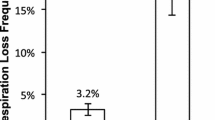Summary
The purpose of the experiments reported below was to examine the response in sporulation medium of the three diploid cell types MATα MATα, MATα MATα (asporogenic diploids) and MATα MATα (sporogenic diploid) to erythromycin, a specific inhibitor of mitochondrial protein synthesis (MPS) in vegetative cultures, and cycloheximide, a specific inhibitor of cytosol protein synthesis (CPS) in vegetative cultures. When MATα MATα diploids are transferred to sporulation medium a significant fraction of total protein synthesis (CPS + MPS) becomes sensitive to erythromycin in contrast to the behavior of MATa MATa and MATα MATα diploids in which the resistance of CPS to erythromycin is maintained. The decompartmentalization of erythromycin sensitivity is thus cell type specific. Erythromycin stimulates total RNA synthesis of MATα MATα cells in sporulation medium but not of MATα MATα and MATα MATα cells. Cycloheximide inhibits protein synthesis and stimulates RNA synthesis in all three diploid cell types. An erythromycin resistant mutant, shown to be due to a mutation of the mitochondrial genome, exhibited only partial resistance of CPS to erythromycin in sporulation medium in the background of the MATα MATα mating type genotype. Total RNA synthesis in this mutant was not stimulated. The results reported indicate that mitochondrial functions during sporulation are not restricted to those involving respiratory metabolism.
Similar content being viewed by others
References
Aronson AI, Spiegelman S (1961) Biochim Biophys Acta 53:84–95
Croes AF (1966) Exptl Cell Res 41:452–454
Ephrussi nB (1953) Clarendon Press, Oxford
Ephrussi B, Hottinguer H, Tavlitzki J (1949) Ann Inst Pasteur 76:419–450
Esposito MS, Esposito RE, Arnaud M, Halvorson HO (1969) J Bacteriol 100:180–186
Esposito MS, Esposito RE (1974) Proc Natl Acad Sci USA 71:3172–3176
Esposito MS, Esposito RE (1974) Genetics 78:215–225
Fast D (1973) J Bacteriol 116:925–930
Friis J, Roman H (1968) Genetics 59:33–57
Hopper AK, Hall BD (1975) Am Soc Microbiol
Hopper AK, MaGee PT, Welch SK, Friedman M, Hall B (1974) J Bacteriol 119:619–628
Kennel D (1967) In: Grossman L, Moldave K (eds) vol XII, part A. Academic Press, New York, pp 686–693
Kuenzi MT, Tingle NA, Halvorson HO (1974) J Bacteriol 117:80–88
MaGee PT (1974) Mol Biol Rep 1:275–281
MaGee PT, Hopper AK (1974) J Bacteriol 119:952–960
Magni GE, Von Borstel RC (1972) Genetics 47:806–814
Mills D (1972) J Bacteriol 112:510–526
Mills D, Schiller M, Petryna MM (1977) Mol Gen Genet 156:71–78
Muto A, Kimura A, Osawa S (1975) Mol Gen Genet 139:321–327
Pearson NJ, Haber JE (1977) Mol Gen Genet 158:81–91
Pinon R, Salts Y, Simchen G (1974) Exp Cell Res 83:952–960
Pratje E, Schultz R, Schniere S, Michaelis G (1979) Mol Gen Genet 176:411–415
Puglisi PO, Zennaro E (1971) Experientia 27:963–964
Roman H, Sands SM (1959) Proc Natl Acad Sci USA 39:171–179
Roth R (1973) Proc Natl Acad Sci USA 70:3087–3091
Roth R, Lusnak K (1970) Science 168:225–261
Roth R, Fogel S (1971) Mol Gen Genet 112:259–305
Roth R, Halvorson HO (1969) J Bacteriol 98:831–832
Simchen G (1974) Genetics 76:745–753
Sogin SG, Haber JE, Halvorson HO (1972) J Bacteriol 112:2, 806–814
Tingle M, Singh Klar AJ, Henry SA, Halvorson HO (1973) Symp Soc Gen Microbiol 23:209–243
Zennaro E, Falcone C, Frontali L, Puglisi PP (1976) Mol Gen Genet 150:136–140
Author information
Authors and Affiliations
Rights and permissions
About this article
Cite this article
Marmiroli, N., Tassi, F., Bianchi, L. et al. Erythromycin and cycloheximide sensitivities of protein and RNA Synthesis in sporulating cells of Saccharomyces cerevisiae: Environmentally induced modifications controlled by chromosomal and mitochondrial genes. Curr Genet 4, 51–62 (1981). https://doi.org/10.1007/BF00376786
Received:
Issue Date:
DOI: https://doi.org/10.1007/BF00376786




